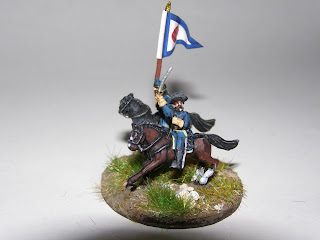In my last post I said it would be Confederates that were on my painting table. This was true, however, a flag shortage meant that work is still ongoing as I await a delivery in the post of more flags.
However, I have been doing something completely different and playing a wargaming board game. This is a new departure for me if I don't count X-Wing or Wings of Glory, which are somewhat different.
I have read many posts on playing board games but I never took the leap, I think, because they don't involve the traditional painted pieces. Also the strict format seemed constraining. I bought a hex wargame from a magazine in about 1982, but could never get my head around it and it just looked...well, a bit dull!
Above we see 10 Group under some serious pressure. All aircraft have returned to base following combat. There are no combat ready squadrons as reserves. There is a large collection of damaged squadrons on the left that have insufficient resources to carry out repairs. 'A Flight' is down to 2 Squadrons, 'B Flight' is grounded with no serviceable planes and 'C Flight' has one Squadron (these are the cards beneath the planes).
So there we have it. Much more detail written than I intended! I hope this is of help to anyone thinking of buying the game. I really do like it a lot. The minor points really are very small. Once I had curbed my unrealistic expectation of what a board game of this size could feasibly cover, I could then think about the mechanisms and this is when the designer's skill really became apparent to me.
I have played it through twice as solo play. The first game took me about 5 hours as I was reading the rules for the first time too. That was a close game; 44 to 42 Victory Points with the Luftwaffe just taking the victory. It does work as a solo play though the Luftwaffe missions would normally remain secret and unknown to the RAF player. Having said that, even having knowledge of where the Luftwaffe were heading to raid did not help me sometimes, as the RAF player, when my airfields were unserviceable and my surviving fighters in no strength to intercept!
On the second occasion, the RAF had about 50 VPs to the Lufwaffe's 41. I think I became better at resource management on the second occasion, and I was also being a bit too daring with launching long fuel-sapping raids to achieve costly objectives for the Luftwaffe! This second game took about 3 hours.
I think the game was well worth the money. The components are really nice, the game play is very neat and the box art...amazing!
















































































